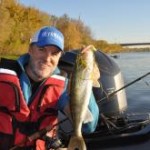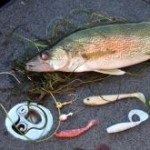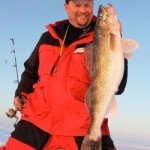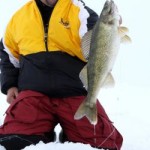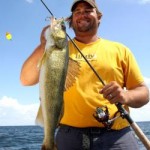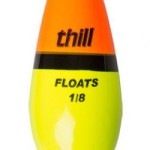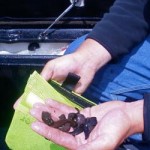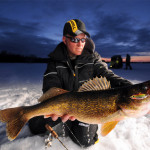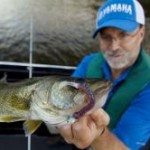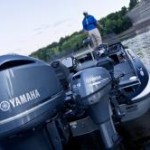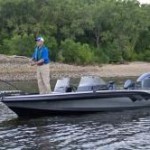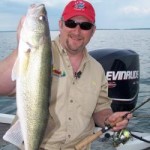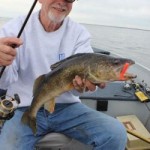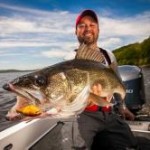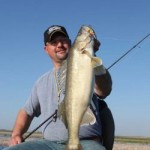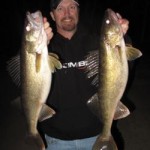Walleye No One Else Can Catch
from The Fishing Wire
Two factors greatly impact walleye fishing success, yet most walleye anglers don’t even consider them.
Steve Pennaz of “Lake Commandos” TV says targeting walleye in weeds can produce big fish missed by other anglers
The first is fishing pressure and it is more intense than anglers realize. Last year, anglers invested 3.05 million hours of fishing effort on Minnesota’s 128,000-acre Lake Mille Lacs. The impact of this much pressure can’t be ignored; it pushes walleye off classic structure and secondary spots often become “A list” fish-catching locations.
Secondly, many lakes across the walleye belt are aging, and their fertility levels are increasing. In some lakes light penetration is too low to support weed growth beyond 7-8 feet of depth. Vegetation draws biodiversity, from micro-invertebrates to baitfish, and that draws in walleye. Drop an Aqua-Vu® underwater camera and the number of walleye in the jungle is surprising.
“When you take a step back and look at the big picture,” said long-time Yamaha pro and ‘Lake Commandos’ television host Steve Pennaz, “it makes perfect sense why we should be spending more time targeting walleye in weeds. Walleye love structure, but they’re also an adaptive animal that utilize weeds often to feed and rest.”
Seek out secondary structure, advises Pennaz, and you may come up with fish like this.So why do so few anglers chase weed walleye? Pennaz believes that many still cling to walleye lore dating back 50 years or more.
“When you revisit the 1960s,” said Pennaz, “two advancements changed walleye fishing forever. The first was sonar. It seems silly today that a dial and flashing light could be considered revolutionary, but ‘the flasher’ opened vast new areas of unexplored water.
“The development of spinning tackle that performed well with monofilament was also huge. For a generation of anglers forced to rely on heavy black Dacron® braid it was a massive move forward. Millions of Mitchell® 300 spinning reels were sold and anglers filled them with monofilament lines made by tackle pioneer Berkley® Bedell.
“Top walleye anglers of the day used these new tools to make amazing catches, typically using light lines, small hooks and live bait. Unfortunately, there are still anglers today who believe the only way to catch walleye is by using finesse rigs and live bait. It wasn’t true then and it’s not true today. In fact, artificial lures routinely out-fish live bait for walleye, which is great because artificials make catching weed-loving walleye easier,” said Pennaz.
Walleye & Salad
An assortment of jigs and soft plastics do the job on walleyes over scattered weeds.
Walleye are not ambush feeders like bass so they prefer sparser areas of weed growth or weed edges.
Summer/early fall fish are active so fishing larger baits is effective. Both cranks and spinner rigs work well when trolled along the deep weed edge.
“Trolling weed edges is tough to beat in summer/early fall … if you can avoid pesky panfish,” said Pennaz. “Live baits like leeches and crawlers are usually mauled in short order making it difficult to keep your presentation in the strike zone.
“Several years ago I made the switch from live crawlers to Gulp!® worms when fishing a weed edge with a bottom bouncer/spinner rig and have been thrilled by the results,” said Pennaz. “The bait is tough enough to withstand panfish attacks and walleye love ’em. My favorite is the 4-inch model; its subtle paddle tail swims realistically even at slow speeds.”
Jig worms are also deadly on weed walleye.
“A bass fishing friend told me about all the walleye he was catching on jig worms when targeting weed line bass,” he said. “At first I thought he was joking, but it soon became clear he wasn’t.
“I typically fish a 4- to 6-inch worm on an 1/8 or 1/4-ounce mushroom head jig. Long casts parallel to the weed line are best. In most waters, this technique produces both walleye and bass,” said Pennaz.
Swimbaits can also be effective for walleye in the right place and at the right time.In early spring, shallow flats hold a lot of walleye, particularly when located near prime spawning areas.
Light jigs in the 1/16- to 1/8-ounce range are ideal, particularly when paired with a durable soft bait. A swimming grub or 3-inch swimbait is tough to beat on windy days, and when more finesse is required, Pennaz recommends switching to presentations like a 3- or 4-inch Berkley® Power Minnow, Gulp!® Minnow or Twitchtail Minnow fished bare.
“If you absolutely must fish live bait for confidence reasons,” said Pennaz, “tip the jig with an inch-long piece of nightcrawler.”
“Target flats in the 2-6-foot range and cover a ton of water as the fish are typically scattered.”
Cranks are also deadly. The best walleye cranks cast well on spinning gear and have a tight wobble. Pennaz’s favorite crankbait is the #5 Flicker Shad in black/gold; he’ll upsize to a #7 when fishing deeper. In both cases he throws the cranks on 8-pound Nanofil® for maximum casting distance and sensitivity… you’ll know immediately if the bait is fouled.
As summer approaches, walleye move to mid-depth weeds; 4-8 feet is typical in highly stained waters, 8-15 feet in clear waters.

